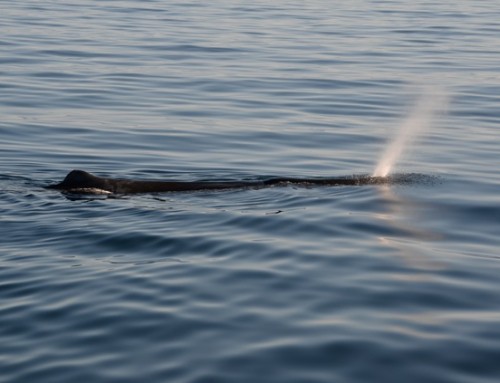The Guadalupe fur seal (Arctocephalus townsendi) is one of four species of pinnipeds regularly found in the waters around Baja California (for a discussion of pinnipeds in general, please see my Rob-servations Blog #10). There are nine species of fur seals in the world, one in the genus Callorhinus and eight in the genus Arctocephalus. All species of fur seals have many characteristics in common, particularly in regards to anatomy, behavior, and exploitation by humans.
Guadalupe fur seals are members of the pinniped family Otariidae, as is the California sea lion, another Baja pinniped species. All members of this family share various traits that help distinguish them from the other major group of pinnipeds, the family Phocidae (which includes the northern elephant seal and harbor seal, both species found in Baja).
Fur seals (and other otariids) possess an external ear flap, have relatively large front flippers (compared to phocids), are able to rotate their hind flippers forward, can walk quadrupedally when on land, and primarily use their front flippers for propulsion underwater (see Blog #10 for more details).
Otariids are “sexually dimorphic,” a term referring to the differences between male and female members of a species. Many people equate the term with differences in body size, but the term also encompasses other differences, such as the bright colors in some male birds, or the antlers in male deer. In the case of fur seals, body size is a good indicator of sex when viewing adult animals. Male Guadalupe fur seals are almost twice as long and 3-4 times heavier than adult females. As a species, however, Guadalupe fur seals are modest in size. Adult males reach about 2 m (6.6 ft) in length and about 160-170 kg (350-370 lbs) in weight, while females average 1.5 m (5 ft) and 40-50 kg (90-110 lbs). While in Baja, the only species with which you may confuse the fur seals is the California sea lion. However, adult California sea lions are noticeably longer and weigh about twice as much as fur seals.
Oftentimes a size disparity between male and female mammals suggests a polygynous mating system, in which a few males mate with many females. Guadalupe fur seals have such a mating system, where bulls compete with each other for control of desirable sections of beach. The dominant male defends his territory, and his harem of females, from other males. The average harem size is about six females. Guadalupe fur seals mate in the summer. Consequently, we do not see adult males or mating behavior during our Natural History tours, which run February to April (we do see elephant seal mating behavior, which occurs during our tour season).
Despite the summer breeding season, we do see fur seals during our February to April tours. Early in the trip, we spend a day hiking around West San Benito Island, one of the three San Benito Islands off the west coast of the Baja peninsula. Younger, presumably non-breeding fur seals, occupy various sites around West San Benito Island at this time of year.
Interestingly, in the 11 years that I’ve been leading Searcher trips, I’ve witnessed the fur seals move their haul-out sites among the San Benito Islands. For a couple of years during this time, the seals were hauled out on East San Benito Island, where we observed them from the Searcher’s skiffs. A few years later, they were hauled out along the southern coast of West San Benito Island. Most recently, the majority of fur seals have been using the northwest coast of West San Benito Island. Of course, individual fur seals can be found anywhere in the San Benito Islands, but the primary haul-out site seems to change over time (at least during our observation period of January through April).
Even more interesting is the history of human exploitation of the Guadalupe fur seal and the role of the San Benito Islands in their comeback. All species of fur seals were hunted mercilessly in the 19th century, to the point where they became “commercially extinct” (i.e., there were so few animals left that it wasn’t cost-effective to hunt them anymore). In the case of the Guadalupe fur seal, the species was thought to be biologically extinct. In 1954, an expedition to Guadalupe Island (northwest of the San Benito Islands) confirmed that a remnant population of a few hundred fur seals remained. With subsequent protection, that population has now grown to about 17,000 individuals. Despite that encouraging growth trend, the population size is still very small. While at first only found on Guadalupe Island, the breeding population has grown large enough that some individuals have colonized other islands for breeding, most notably the San Benito Islands in 1997. Thus, the San Benito Islands are a crucial habitat for the continued recovery of this species.
I mentioned earlier that the only species with which you might confuse the Guadalupe fur seal is the California sea lion. We do see lots of sea lions on our Searcher Natural History tours in Baja, including at the San Benito Islands. Some identification characteristics should allow you to separate them. As mentioned, California sea lions are larger than Guadalupe fur seals, about twice as heavy. Fur seals are darker, on average, than sea lions, with the coat of fur seals appearing dark brown to almost black. Sea lion color is highly variable, often depending on how wet the animal is. A sea lion just coming out of the water is usually dark brown, while a dry sea lion hauled out for hours may appear almost blond. The snout of a Guadalupe fur seal is more tapered and pointy compared to the relatively more-blunt snout of a sea lion. Perhaps the best character is the shaggy mane of the fur seal; the hair around the neck of fur seals is thicker than the relatively shorter fur of sea lions.
To the uninitiated, Guadalupe fur seals look like shaggy sea lions. And with sea lions so omnipresent on our trips, I think many people overlook the significance of seeing these fur seals. During the course of each Searcher Natural History tour, we witness the majesty of giant whales, the spectacle of a thousand dolphins in a single herd, and the wonder of innumerable other sights. But I always make a point of saying, while we gaze down upon a group of sparring fur seals playing in a wave-battered tide pool, that we are looking at the rarest of all the marine mammals that we will see on this trip.
Note: recent scientific opinion suggests that the Guadalupe fur seal is a subspecies of Arctocephalus philippii, with the other subspecies being the Juan Fernandez fur seal (found in the Juan Fernandez Islands off of Chile). Both subspecies share a history of exploitation to the point of near extinction, and a recent history of protection and population growth.
–Rob Nawojchik, Searcher Natural History Tours naturalist






